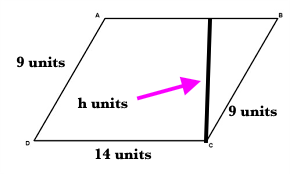A parallelogram has sides with lengths of #14 # and #9 #. If the parallelogram's area is #42 #, what is the length of its longest diagonal?
1 Answer
Here is a diagram.
Explanation:

The image shows that the height of this parallelogram is unknown. The formula for area of a parallelogram is
Now that we know two sides, we can use SOHCAHTOA to determine the measure of angle B.
We know the side opposite B and the hypotenuse. We will therefore use
Since opposite angles in parallelograms have equal measures, we can conclude that
The total angles in a parallelogram add up to
Solving the system of equations:
Now that we know the measure of A, the length of
Hopefully this helps!

